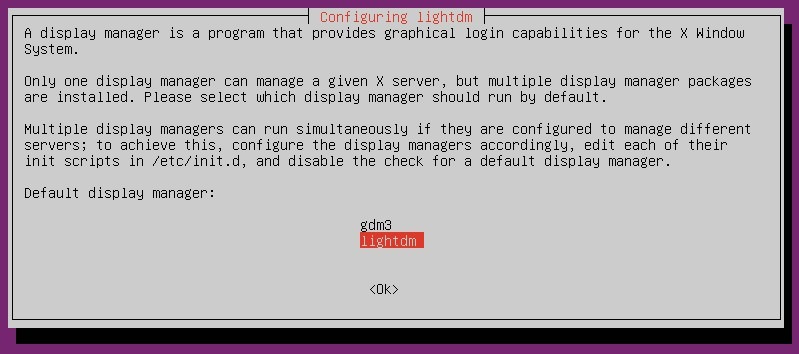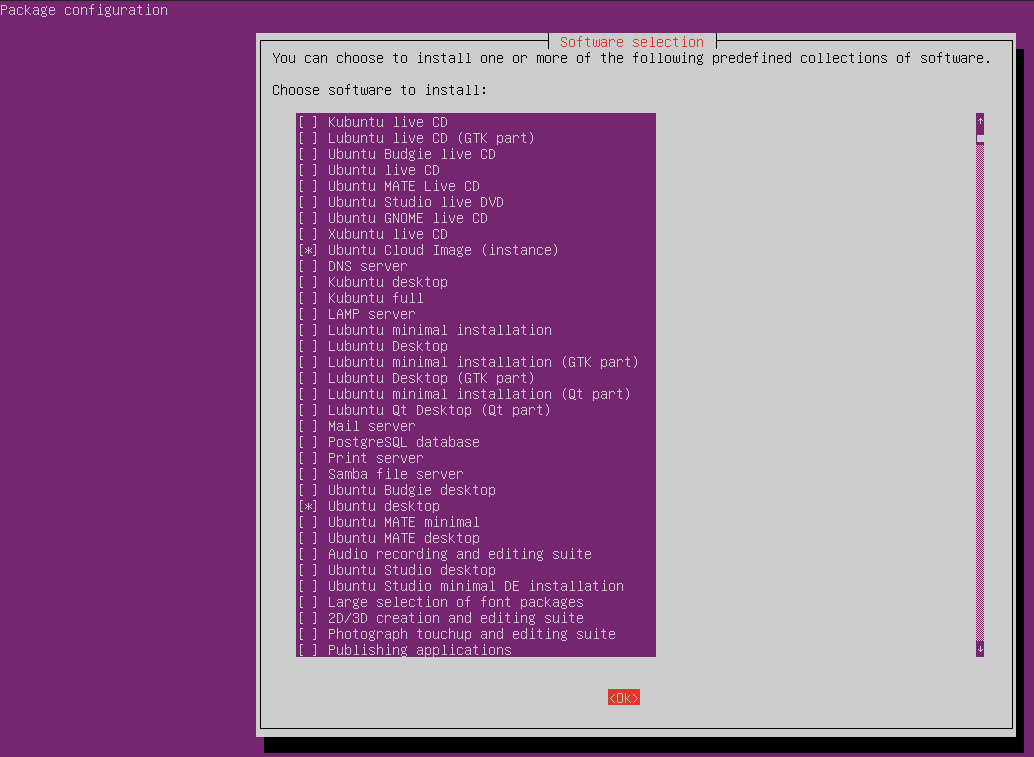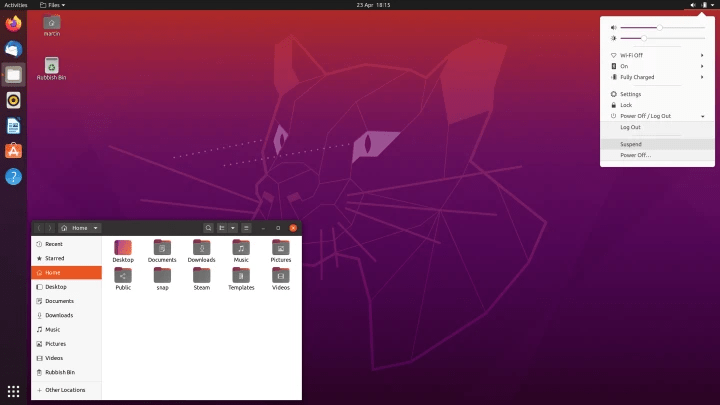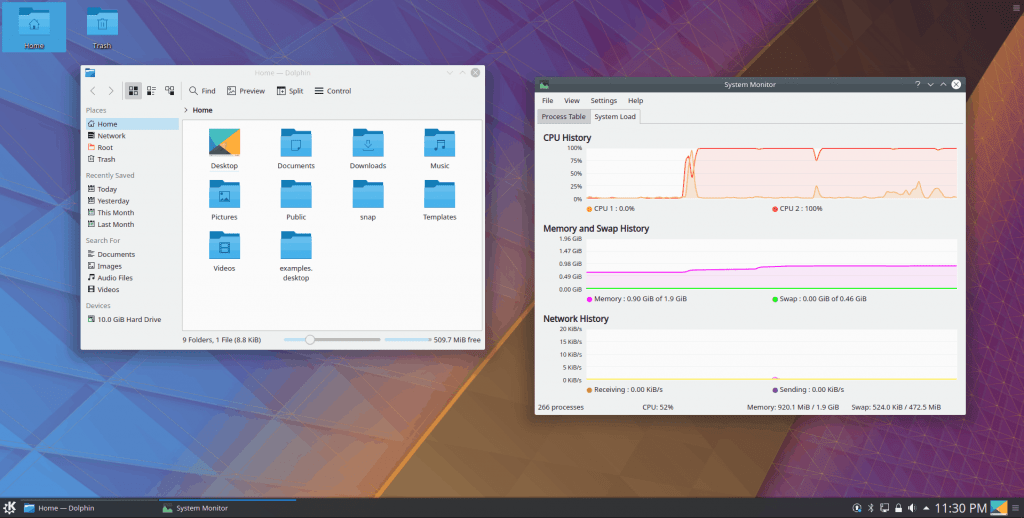How To Install Graphical Interface On Ubuntu Server
Tin't discover a desktop after you installed Ubuntu Server? That unexpected dark screen got you downward? Well, you're not the only i. When I got my first VPS, I immediately installed Ubuntu. But when I saw that expressionless screen with only a few lines of text, I was sure something had gone wrong with the installation — information technology didn't look anything like the Ubuntu I had on my laptop! So, what's happened and why are nosotros in this mess? And how to install GUI on on Ubuntu Server? That'southward what this post is trying to answer.
The first department deals with the why and how, placing the problem in context. The second section helps you choose the right GUI to install. If you're just here for the fix, all the same, feel free to skip right to instructions on how to install GUI on Ubuntu Server . Just follow the simple, brusque steps provided in patently English and you'll get things done in no fourth dimension. And make sure to stick around to the cease, where I'll reveal a shortcut that tin can hands cut through all the hassle.
What is Ubuntu Server and Why Does information technology Matter?
Ubuntu Server is an Ubuntu edition geared for use as a server operating organization. Equally a Linux distro, Ubuntu is among the all-time favorites for use on workstations and laptops. The server edition is, if annihilation, even more than popular amidst server-specific operating systems and that has merely increased in recent years. The reason it'due south so in demand? It'south just that good! Permit's take a look at some of its best features.
- Like shooting fish in a barrel Container Deployment
- Lightweight Distro
- Perfect Cloud Integration
- Incredible Hardware Support
Ubuntu Server delivers all the features in demand today and that's probably why you chose information technology too. Then, why does it not include a GUI desktop amongst all these absurd features? The fact is that well-nigh server operating systems are designed to be as lightweight equally possible, leaving more resources for the things you want to do with the server. That'southward why most of them only dispense with the GUI in favor of a Command-Line Interface (CLI).
A CLI may piece of work for hardcore server admins and developers simply for the rest of united states, it makes things a lot harder. That's why Ubuntu Server lets you install a GUI desktop of your choice with just a few commands. That's besides why you are reading this mail, so should nosotros become to it?
If you're not sure what your options for a GUI desktop are or which one is better for you, then the side by side section should take care of that. If yous accept already fabricated a option, skip ahead to my guide on how to install GUI on Ubuntu Server ..
How to Choose the All-time Ubuntu GUI?
If yous're more than used to Windows or Mac than Linux, then the idea of choosing between different desktops may seem strange. Really, having a selection in the matter makes things more interesting. So, what are our choices here?
Linux Hosting Simplified
Want a ameliorate way to host your websites and spider web apps? Developing something new? Simply don't like Windows? That's why we have Linux VPS.
Become your Linux VPS

Best Ubuntu GUIs:
- GNOME
- KDE Plasma
- MATE
- Xfce
GNOME
GNOME is the most pop GUI desktop for Linux distros. Information technology is also the default GUI in Ubuntu'southward workstation edition (the one for personal computers like your laptop). The fact that information technology is native to Ubuntu is more than than enough to make GNOME a strong candidate for the position of All-time Ubuntu GUI. What else has it going on?
Top GNOME Features:
- Very Stable
- Regular Updates
- Active Customs
- Lots of Apps
In terms of looks, GNOME is not very customizable (hardly customizable would be more than accurate) without some complicated workarounds. But it does make upwardly for it with a great design. It may counterbalance a chip too heavily on RAM and CPU performance, and that may be a problem if your server has express resource to spare. To sum things up, GNOME is not the default desktop environment for zippo, with numerous pros to each con.
KDE Plasma
The other staple GUI desktop for Linux distros is KDE Plasma. While non as popular as GNOME, it is a mainstream desktop in its own right and it has the features to back that up:
Top KDE Plasma Features:
- Lightweight
- Piece of cake to Use
- Highly Customizable
- Active Community
KDE Plasma is, without a question, the most customizable Linux desktop e'er. Y'all can change whatsoever and all aspects of its advent with just a few clicks. Its design is also inspired by Windows, significant a similar taskbar and first menu with familiar icon placements. If it has a fewer number of applications, the ones it does have on offering are powerful plenty to trounce any 1 GNOME app. Mayhap the most important characteristic to consider when information technology comes to KDE Plasma as a server OS, however, is how resource-efficient it is. If you don't accept a lot of resources or need them for more important tasks, KDE Plasma is perfect.
All in all, KDE Plasma is a great style to keep overhead low while getting a more "normal" feel using Linux, especially if yous're used to Windows.
MATE
MATE is an old hand at providing an eye-catching but lightweight desktop experience. It'south even more than resource-efficient than KDE Plasma, making it a great choice as the GUI for a server OS.
Meridian MATE Features
- Extremely Resource-Efficient
- Intuitive Blueprint
- Time-tested
MATE is actually based on GNOME ii, an older version of the near popular desktop environment. Despite its origins, however, MATE is very much its own GUI, with a Windows-like design and very fast performance. Some experts fifty-fifty consider information technology to be even more than lightweight than Xfce, and so if yous like to keep some beauty to your server OS but still trim it down as far every bit it tin can go, MATE is the way to go.
Xfce
When it comes to lightweight desktop environments, Xfce is usually one of the top three; and it's the most resources-efficient GUI desktop on this list. That calorie-free touch, yet, comes at the prices of less-modern graphics. It may not be the best choice for a laptop or workstation, but if you lot're using a server with limited resource, like a VPS, and you don't heed outdated graphics, and then Xfce is definitely the all-time Ubuntu GUI for you. It lets you lot devote what resources you have to the tasks that actually affair, like handling web traffic or running your web app.
How to Install GUI on Ubuntu Server
With no further introductions, here's how to install GUI on Ubuntu Server. Get-go of all, I'thousand assuming you lot accept full root access to your server, meaning you have permission to run sudo or superuser-level commands. If you're using a VPS and don't know exactly how to establish a remote connection and get the last running, y'all should read our tutorial on connecting to a remote Linux server .
Step 1: Updating your Repositories
If y'all've used a Linux distro before, you know that installing most software packages is done using the CLI to connect to a package repository and downloading the files. Before you tin download your GUI desktop of option, however, yous demand to make sure your repositories are updated. That ensures you get the terminal, most stable version of the GUI yous want to install.
To update your repositories, enter the post-obit command:
sudo apt-go update && sudo apt-get upgrade Printing <Y> if you lot're asked whether you lot want to continue with updating the packages.
This command will check the latest versions of all software packages with the repositories. That may accept a couple of minutes depending on your Cyberspace connexion and how recent the Ubuntu Server prototype y'all used in your installation is.
When the update is finished and you're back to the command prompt, information technology'south time to get things started for real.
Linux Hosting Simplified
Want a better way to host your websites and web apps? Developing something new? Simply don't like Windows? That's why we have Linux VPS.
Get your Linux VPS

Step 2: Setting upward a Display Manager
To simplify the installation of the packages we are going to need here, we will first install a parcel called tasksel manager. This Linux utility software allows you to download and install several connected packages and requirements with a single command. That makes the installation of larger software like a GUI desktop surroundings much easier. Of form, yous can also utilise the native apt to install the desktop environment of your choice, and I'll provide instructions for both.
But wait; if you lot feel like things are moving as well fast, or find yourself thinking "what'southward with these commands," then you may wanna cheque out the 10 Linux commands every user should know .
I recommend you use tasksel, all the same, because at that place is less chance of things going wrong because of package dependencies. To install tasksel, type the post-obit into the Ubuntu concluding:
sudo apt-get install tasksel -y When tasksel is finished installing, we can move on to selecting and installing a display manager for Ubuntu Server.
Brandish managers are software packages responsible for launching the graphics of a desktop surroundings on Ubuntu Server. In that location are multiple display servers to choose from, each with their ain features and use cases, but for a first-fourth dimension installation, you are better off with either SliM or LightDM. Both of them are light and fast, adding piffling overhead. SliM is usually considered the best display managing director around, with lots of documentation and tutorials available. LightDM is a close second, then choosing either one is fine. Read Slant'southward comparison of the two if you desire to know more almost their differences.
To install SLiM, utilise the following command:
sudo apt-become install slim -y If you lot have decided on LightDM, all the same, make certain to enter the one below:
sudo apt-get install lightdm -y There is also a third selection to consider when it comes to display managers, but only if you're planning on installing KDE Plasma as the GUI of your choice. SDDM is the native display director of the KDE Plasma desktop surroundings and installing it will make sure the desktop runs smoothly:
sudo apt-get install sddm -y
Since neither of these 3 are the native display manager for GNOME, it'south possible you lot'll see a message asking you to confirm which brandish director you'd like as the default: the native (but heavy) GDM3 or LightDM (or SLiM, or SDDM). If that happens, but choose the ane you merely installed, and printing <OK> using the keyboard.

Now, it'due south onward to the next step — we are almost getting prepare to actually install GUI on Ubuntu Server but if you're feeling drained and exhausted thinking about all the things left to exercise, call back to read on the cease, where I'll reveal the ultimate shortcut.
Step iii: Downloading and Installing your Favorite GUI
Past now, you should know which of the bachelor GUI desktop environments yous desire to install on your Ubuntu Server. If not, you tin ever have another peek at our comparison of top contenders. Here, y'all'll find the instructions for installing each of the desktops we discussed.
Installing GUI on Ubuntu Server
- Installing GNOME
- Installing KDE Plasma
- Installing MATE
- Installing Xfce
Installing GNOME
To install GNOME using tasksel, you can use either one of the following methods: using tasksel from the command line or using the tasksel UI. To install GNOME on Ubuntu Server using tasksel from the command line, enter the post-obit command:
sudo tasksel install ubuntu-desktop If you prefer a more convenient manner, you can use the minimal user interface of tasksel and select the right parcel bundle. First, y'all'll have to start tasksel past running it from the terminal:
Tasksel Tasksel volition then greet you with a sort of minimal GUI that lets you select the bundle bundle (collection of software, as tasksel itself calls information technology) yous desire. As y'all can run across in the screenshot below, there is a bundle called "Ubuntu desktop" about midway downwards the list.

Navigate the list using the arrows keys and when you get to "Ubuntu desktop," press <Space> to select it. Once y'all've got it marked, utilise <TAB> to move the cursor down to the button that says OK at the very bottom of the UI. Press <ENTER> to finalize your choice and start the download and installation of GNOME equally the GUI desktop of your Ubuntu Server.
If you'd like to employ apt instead of tasksel, you can install GNOME using the following control:
sudo apt-get install ubuntu-desktop Whatever method you've followed, the installation may accept some time to finish, and when it'south done, your system will automatically reboot. Once Ubuntu Server is dorsum online, you'll see, to your relief (at least that's how I felt!), that there is a graphic login screen waiting for y'all. One time you lot enter your account, y'all'll be faced with something that commonly looks something like this:

In the rare upshot of Ubuntu Server booting upwardly once again to a CLI, yous can simply force it to first the desktop using the following command:
If you have chosen LightDM:
sudo service lightdm start
If you have SLiM:
sudo service slim showtime With this, you lot've managed to successfully install GUI on Ubuntu Server for the first time. If you've had some trouble going through the steps and would prefer a simpler culling, or if you lot're just curious about that ultimate shortcut I promised at the start, you can skip ahead to the conclusion.
Installing KDE Plasma
Since tasksel does not include a KDE Plasma packet, we volition take to utilize the good erstwhile apt-get to install this highly customizable desktop. To do that, enter the post-obit line into the terminal:
sudo apt install kde-plasma-desktop That may take a while to finish, so sit back and relax. When the installation is done, your system may reboot and offset up once again in CLI-manner. To beginning the KDE Plasma GUI, you have to force the display manager to launch it:
If you've chosen SDDM as your display manager:
sudo service SDDM first
If you lot've chosen LightDM:
sudo service lightdm start
If you've chosen SLiM:
sudo service slim kickoff That should get you a proficient-looking, lightweight GUI desktop looking something like this:

Found all that as well complicated or ran into arcane errors? Well, make sure to stick effectually for the shortcut I will reveal in the conclusion.
Installing MATE
If you've settled on MATE, you have made a well-counterbalanced choice. To install MATE, you can use both tasksel and apt-get. You tin can run the post-obit control to install the GUI desktop using tasksel:
sudo tasksel install ubuntu-mate-core If you lot'd rather use the native apt-get installer to fix MATE, you can utilize the command below:
sudo apt-get install ubuntu-mate-cadre -y The installation volition start either fashion and information technology volition take a while before it's finished. In one case the system reboots and Ubuntu Server boots back up, you'll exist able to use a GUI login screen to enter a GUI desktop. Enjoy the unique colour palette of MATE.
Installing Xfce
The final desktop environment we embrace volition be the well-known lightweight champion, Xfce. Xfce itself tin just be installed from the command-line using:
sudo apt-go install xfce4 slim -y Simply if you want to use tasksel, or if y'all'd rather sacrifice just a flake of additional resources for a more dynamic look, y'all can try installing Xubuntu, an Xfce-based desktop environment:
sudo tasksel install xubuntu-cadre
Of grade, Xubuntu can also exist installed using apt-get:
sudo apt-get install xubuntu-cadre -y
Step four: Forcing your GUI Desktop to Start and Stop
Every bit I mentioned in some of the instructions, there is a chance the GUI does non automatically start up after installation and reboot. There is a fashion to force your display managing director to first your desktop environment in such cases. To offset the GUI, enter the post-obit command into the terminal:
sudo service DISPLAY_MANAGER* get-go
*where DISPLAY_MANAGER is the proper name of the display manager you installed at the outset (lightdm, slim, or sddm).
In case yous ever need to leave the GUI and turn your server dorsum to CLI fashion, open the terminal and enter the post-obit command.
sudo service DISPLAY_MANAGER* stop
*where DISPLAY_MANAGER is the name of the display director you installed at the beginning (lightdm, slim, or sddm).
What Now?
By now y'all ought to have picked your favorite GUI desktop surround and installed it on your Ubuntu Server. Whatever desktop you have installed, there are a lot of things still left to exercise before yous have a properly configured server. So, at the very least, brand sure to read our weblog'due south tutorial on how to make your Linux server more secure .
Linux Hosting Simplified
Want a better way to host your websites and spider web apps? Developing something new? Simply don't like Windows? That's why we have Linux VPS.
Get your Linux VPS

Had bug with the setup, or just exhausted from trying to install GUI on Ubuntu Server? That'south only too relatable. I know that sometimes problems pop upward where yous least expect them and finding the right mode to deal with those problems is not always obvious. That is exactly why I promised to show you all a shortcut that lets you bypass all these abrasive issues and complexities. If y'all need an Ubuntu Server with a GUI desktop, why non simply utilize the Cloudzy Ubuntu VPS solutions? Yous can install any version of Ubuntu Server together with whatever desktop environment yous like. With fifteen+ global server locations running Ubuntu VPS on height-tier infrastructure, your Ubuntu Server will be always online and ever bachelor. Plus, you lot won't accept to limit yourself to resource-efficient GUI desktops anymore — install whatever you want with easy scaleup options. Did I mention the competitive prices yet?
24
0
Source: https://cloudzy.com/knowledge-base/how-to-install-gui-on-ubuntu-server/
Posted by: paulltherob.blogspot.com



0 Response to "How To Install Graphical Interface On Ubuntu Server"
Post a Comment